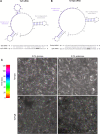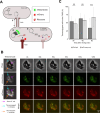Modulation of Vibrio cholerae gene expression through conjugative delivery of engineered regulatory small RNAs
- PMID: 39292012
- PMCID: PMC11500501
- DOI: 10.1128/jb.00142-24
Modulation of Vibrio cholerae gene expression through conjugative delivery of engineered regulatory small RNAs
Abstract
The increase in antibiotic resistance in bacteria has prompted the efforts in developing new alternative strategies for pathogenic bacteria. We explored the feasibility of targeting Vibrio cholerae by neutralizing bacterial cellular processes rather than outright killing the pathogen. We investigated the efficacy of delivering engineered regulatory small RNAs (sRNAs) to modulate gene expression through DNA conjugation. As a proof of concept, we engineered several sRNAs targeting the type VI secretion system (T6SS), several of which were able to successfully knockdown the T6SS activity at different degrees. Using the same strategy, we modulated exopolysaccharide production and motility. Lastly, we delivered an sRNA targeting T6SS into V. cholerae via conjugation and observed a rapid knockdown of the T6SS activity. Coupling conjugation with engineered sRNAs represents a novel way of modulating gene expression in V. cholerae opening the door for the development of novel prophylactic and therapeutic applications.
Importance: Given the prevalence of antibiotic resistance, there is an increasing need to develop alternative approaches to managing pathogenic bacteria. In this work, we explore the feasibility of modulating the expression of various cellular systems in Vibrio cholerae using engineered regulatory sRNAs delivered into cells via DNA conjugation. These sRNAs are based on regulatory sRNAs found in V. cholerae and exploit its native regulatory machinery. By delivering these sRNAs conjugatively along with a real-time marker for DNA transfer, we found that complete knockdown of a targeted cellular system could be achieved within one cell division cycle after sRNA gene delivery. These results indicate that conjugative delivery of engineered regulatory sRNAs is a rapid and robust way of precisely targeting V. cholerae.
Keywords: T6SS; V. cholerae; conjugation; modulation gene expression; sRNAs.
Conflict of interest statement
The authors declare no conflict of interest.
Figures




Similar articles
-
Characterization of quorum regulatory small RNAs in an emerging pathogen Vibrio fluvialis and their roles toward type VI secretion system VflT6SS2 modulation.Emerg Microbes Infect. 2024 Dec;13(1):2396872. doi: 10.1080/22221751.2024.2396872. Epub 2024 Sep 30. Emerg Microbes Infect. 2024. PMID: 39193622 Free PMC article.
-
Engineered Type Six Secretion Systems Deliver Active Exogenous Effectors and Cre Recombinase.mBio. 2021 Aug 31;12(4):e0111521. doi: 10.1128/mBio.01115-21. Epub 2021 Jul 20. mBio. 2021. PMID: 34281388 Free PMC article.
-
Pesticin-Like Effector VgrG3cp Targeting Peptidoglycan Delivered by the Type VI Secretion System Contributes to Vibrio cholerae Interbacterial Competition.Microbiol Spectr. 2023 Feb 14;11(1):e0426722. doi: 10.1128/spectrum.04267-22. Epub 2023 Jan 10. Microbiol Spectr. 2023. PMID: 36625646 Free PMC article.
-
Non-coding sRNAs regulate virulence in the bacterial pathogen Vibrio cholerae.RNA Biol. 2012 Apr;9(4):392-401. doi: 10.4161/rna.19975. Epub 2012 Apr 1. RNA Biol. 2012. PMID: 22546941 Free PMC article. Review.
-
The Vibrio cholerae type VI secretion system: toxins, regulators and consequences.Environ Microbiol. 2020 Oct;22(10):4112-4122. doi: 10.1111/1462-2920.14976. Epub 2020 Mar 13. Environ Microbiol. 2020. PMID: 32133757 Review.
References
Publication types
MeSH terms
Substances
Grants and funding
LinkOut - more resources
Full Text Sources
Research Materials

